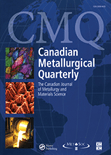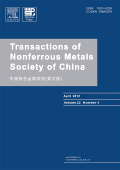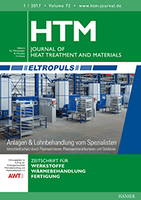
CIS Iron and Steel Review
Scope & Guideline
Championing Open Access for Industrial Insights
Introduction
Aims and Scopes
- Metallurgical Processes and Technologies:
The journal emphasizes research on various metallurgical processes, including smelting, casting, rolling, and treatment of steel and iron ores. It explores innovative technologies such as additive manufacturing and advanced heat treatment methods. - Materials Science and Engineering:
A core focus is on the properties and behaviors of different steel grades and alloys, including their mechanical, thermal, and chemical characteristics. The journal publishes studies on microstructural evolution and phase transformations. - Corrosion and Wear Resistance:
The journal addresses issues related to the corrosion resistance and wear properties of steel, particularly in harsh industrial environments. Research on protective coatings and alloying elements is commonly featured. - Environmental Sustainability:
Research related to the recycling of metallurgical wastes, reduction of emissions, and sustainable practices in steel production is prevalent. The journal highlights studies on the environmental impact of metallurgical operations. - Digital Technologies and Simulation:
The integration of digital technologies, such as machine learning and finite element modeling, in metallurgy is a significant area of focus. The journal showcases efforts to optimize production processes through computational methods.
Trending and Emerging
- Advanced Manufacturing Technologies:
There is an increasing focus on innovative manufacturing techniques such as additive manufacturing (3D printing) and hybrid manufacturing processes, which aim to enhance production efficiency and material properties. - Machine Learning and AI Applications:
The use of machine learning and artificial intelligence in optimizing metallurgical processes and predictive modeling is on the rise, indicating a shift towards data-driven methodologies in metallurgy. - Sustainable Practices and Recycling:
Research on recycling metallurgical by-products and improving the sustainability of steel production processes has gained momentum, reflecting a broader industry trend towards environmental responsibility. - High-Performance Alloys and Coatings:
The development of new high-performance alloys and specialized coatings to improve corrosion resistance and operational longevity in extreme conditions is increasingly prevalent, driven by the demands of modern applications. - Digital Twin Technologies:
The implementation of digital twins for simulating and optimizing metallurgical processes is emerging as a significant trend, showcasing the industry's move towards digital transformation and smart manufacturing.
Declining or Waning
- Traditional Metallurgical Processes:
Research on conventional methods such as basic smelting and casting has become less common, possibly due to the industry's shift towards more innovative and efficient technologies. - Low-Temperature Processing Techniques:
Studies focused on low-temperature processing methods, such as those used in older casting techniques, have diminished, likely due to the rising emphasis on high-temperature processing and advanced material properties. - Basic Alloy Development:
The exploration of traditional alloy compositions is waning as the field moves towards more complex, high-performance alloys designed for specific applications, particularly in extreme environments. - Historical Metallurgical Practices:
Research that focuses on historical techniques and practices in metallurgy has become less prevalent, replaced by studies that emphasize modern technological advancements and their applications.
Similar Journals

Letters on Materials
Advancing materials science through innovative insights.Letters on Materials, published by the Russian Academy of Sciences, Institute of Metals Superplasticity Problems, serves as a vital platform in the diverse field of materials science. Established in 2014 and running through 2024, this journal has carved a niche as a Q3 category publication, focusing on innovative research and developments in materials science and engineering. With its ISSN 2218-5046 and E-ISSN 2410-3535, it provides a unique opportunity for researchers and industry professionals to disseminate significant findings and theoretical advancements within the materials domain. While currently not categorized as open access, the journal maintains a global reach, promoting scientific dialogue and collaboration particularly within the Russian Federation and broader international audiences. Its placement within the 25th percentile in the Scopus rankings underscores its emerging significance, making it essential reading for anyone interested in cutting-edge materials research.

Materiali in Tehnologije
Catalyzing Innovations in Material TechnologiesMateriali in Tehnologije is a distinguished peer-reviewed journal dedicated to the field of materials science, focusing specifically on metals and polymers. Published by the Institute for Metals and Materials Technology in Slovenia, this open-access journal has been at the forefront of disseminating research findings and innovative technologies since 2000. With a current impact factor that reflects its increasing visibility in the academic community, Materiali in Tehnologije serves as an invaluable resource for researchers, professionals, and students alike, encompassing a wide array of studies in the categories of Metals and Alloys, as well as Polymers and Plastics. The journal is indexed in Scopus, highlighting its relevance and contribution to the field, particularly with its ranks of Q3 in Metals and Alloys and Q4 in Polymers and Plastics. As it converges towards 2024, Materiali in Tehnologije continues to be a pivotal platform for knowledge exchange, encouraging advancements in materials research and technology.

CANADIAN METALLURGICAL QUARTERLY
Advancing Metallurgical Knowledge, One Quarter at a Time.Canadian Metallurgical Quarterly is a prestigious scholarly journal published by Taylor & Francis Ltd, dedicated to the field of metallurgical engineering and materials science. With a rich history dating back to its inception in 1962 and continuing through its most recent publications, this journal serves as a vital platform for the dissemination of innovative research, advancements, and critical reviews in metallurgy, metals, and alloys. Positioned strategically within the academic community, it holds a significant impact factor and is currently rated in the Q2 category for Metals and Alloys, and Q3 in Industrial and Manufacturing Engineering as of 2023, showcasing its authoritative role in these disciplines. Although it does not offer open access, the journal remains widely recognized for its rigorous peer-review process, ensuring that published work adheres to the highest standards of scientific quality. Researchers, professionals, and students alike will find invaluable insights and contributions that drive the field forward.

Acta Metallurgica Sinica-English Letters
Innovating Industrial Engineering Through Rigorous Scholarship.Acta Metallurgica Sinica-English Letters, published by the Chinese Academy of Sciences, Institute of Metal Research, is a premier international journal that has been fostering the advancement of knowledge in the fields of Industrial and Manufacturing Engineering and Metals and Alloys since its inception in 1997. With a commendable impact factor and ranking within the top quartiles (Q1) of leading Scopus categories, this journal serves as a vital platform for researchers and professionals to disseminate innovative research findings and groundbreaking methodologies. Notably recognized with a Scopus rank of #34 out of 176 in Materials Science and rank #81 out of 384 in Engineering, it provides a robust space for high-quality, peer-reviewed articles, thus bridging the gap between theoretical advancement and practical application in metallurgy and materials science. Although currently not an open-access journal, its rigorous editorial standards and comprehensive scope ensure that only the most impactful research contributes to the scientific community and industry advancements globally. Acta Metallurgica Sinica-English Letters is an essential read for anyone eager to stay informed on cutting-edge developments within these crucial domains.

TRANSACTIONS OF NONFERROUS METALS SOCIETY OF CHINA
Unveiling insights into the future of metals and alloys.TRANSACTIONS OF NONFERROUS METALS SOCIETY OF CHINA, published by Elsevier, is a premier academic journal that serves as a vital platform for researchers and professionals specializing in materials science, condensed matter physics, geotechnical engineering, and engineering geology. Established in 1994, this esteemed publication has maintained a robust focus on the latest developments in the nonferrous metals sector, reflecting its significant impact in the field with a Q1 categorization across multiple disciplines. With impressive Scopus rankings—placing it in the top 20% of journals in relevant categories—this journal is recognized for its quality and rigor, providing critical insights into metals and alloys, materials chemistry, and their applications. The non-open access format ensures a dedicated readership among professionals and academics seeking substantial and authoritative research articles. By fostering knowledge exchange, the journal strives to advance the understanding and application of nonferrous metals, making it an essential resource for anyone involved in material innovations and engineering solutions.

Metals
Connecting researchers with cutting-edge findings in metallurgy.Metals is an esteemed open access journal published by MDPI, focusing on the diverse field of metallurgical science and its applications. Since its inception in 2011, the journal has provided a platform for the dissemination of high-quality research regarding the behavior, processing, and properties of metals and alloys. With an E-ISSN of 2075-4701, it has quickly established itself within the scientific community, achieving a remarkable Q1 ranking in the realm of Metals and Alloys and a Q2 rank in general Materials Science as of 2023. The journal is situated in Switzerland and is committed to the principles of open access, ensuring that findings are accessible to a broad audience without subscription barriers. With its notable impact factor and a strong emphasis on innovative research, Metals serves as an essential resource for researchers, professionals, and students seeking to advance their knowledge and understanding in the ever-evolving landscape of metallurgical studies.

JOURNAL OF MATERIALS ENGINEERING AND PERFORMANCE
Pioneering Research in Materials EngineeringJOURNAL OF MATERIALS ENGINEERING AND PERFORMANCE, published by Springer, serves as a vital resource for researchers and professionals in the fields of materials science, mechanical engineering, and mechanics of materials. With an ISSN of 1059-9495 and E-ISSN of 1544-1024, this journal boasts a commendable track record since its inception in 1992 and is set to continue providing valuable insights until 2024. Positioned in the Q2 quartile of its categories, the journal is ranked #246 in Mechanical Engineering and #168 in Mechanics of Materials according to Scopus, reflecting its commitment to high-quality research. While currently not adopting an open access model, it remains accessible to academic professionals and students eager to advance their knowledge in the rapidly evolving domain of materials engineering. The scope encompasses innovative research focused on material performance, engineering applications, and technological advancements, making it an indispensable tool for those at the forefront of the field.

HTM-Journal of Heat Treatment and Materials
Connecting academia and industry through cutting-edge research.HTM-Journal of Heat Treatment and Materials, published by WALTER DE GRUYTER GMBH, serves as a vital platform for the dissemination of research in the fields of Industrial and Manufacturing Engineering, Materials Chemistry, and Metals and Alloys. With an ISSN of 1867-2493 and an E-ISSN of 2194-1831, this peer-reviewed journal focuses on the advancements and methodologies associated with heat treatment processes, materials innovation, and their applications across various industries. Notably recognized in the Q3 category for Industrial and Manufacturing Engineering and Materials Chemistry, as well as Q2 for Metals and Alloys, the journal has garnered significant attention, illustrated by its Scopus rankings, placing it among the scholarly discussions within the field. Although it operates under a closed access model, the journal remains committed to impactful research that influences both academia and industry, ensuring its relevance and importance in shaping future developments in materials science. It is an essential resource for researchers, professionals, and students striving to stay at the forefront of heat treatment and materials research.

JOURNAL OF IRON AND STEEL RESEARCH INTERNATIONAL
Uncovering Breakthroughs in Metals and AlloysJOURNAL OF IRON AND STEEL RESEARCH INTERNATIONAL, published by Springer, stands as a leading peer-reviewed journal in the fields of Materials Chemistry, Mechanics of Materials, and Metals and Alloys. With a strong focus on interdisciplinary research, the journal contributes significantly to the advancement of knowledge in these sectors, reflected in its impressive ranking, including Q1 status in Metals and Alloys for 2023. The journal is not only a crucial resource for critical insights into the properties and applications of iron and steel but also serves as a vibrant platform for researchers and professionals to disseminate novel findings ranging from fundamental science to practical engineering applications. With a broad scope that has evolved since its inception in 1996 and maintains a consistent commitment to high-quality research, this journal is essential for students, scholars, and industry experts aiming to keep abreast of the latest developments and innovations in the iron and steel domain.

METALLURGICAL AND MATERIALS TRANSACTIONS B-PROCESS METALLURGY AND MATERIALS PROCESSING SCIENCE
Unlocking the Secrets of Materials Processing and MetallurgyMETALLURGICAL AND MATERIALS TRANSACTIONS B-PROCESS METALLURGY AND MATERIALS PROCESSING SCIENCE, published by Springer, serves as a pivotal platform in advancing the field of materials science, focusing specifically on the intricacies of process metallurgy and materials processing. With an ISSN of 1073-5615 and an E-ISSN of 1543-1916, this esteemed journal boasts an impressive standing with its 2023 category quartiles, ranking Q2 in Condensed Matter Physics, Materials Chemistry, and Mechanics of Materials, while achieving a top-tier Q1 classification in Metals and Alloys. Positioned in the United States, the journal has been publishing leading research since its inception, with converged years spanning from 1973 to 1979 and 1995 to 2024. The journal's robust impact within its fields is reflected in its Scopus rankings, notably ranking #42 out of 176 in Materials Science with a 76th percentile. Though not an open access journal, its comprehensive and high-quality research articles cater to the needs of researchers, professionals, and students, ensuring they remain at the forefront of advancements in metallurgy and materials processing science.